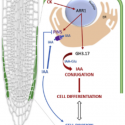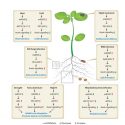Plant Science Research Weekly: March 29th
Review: Exploiting natural variation and genetic manipulation of stomatal conductance for crop improvement
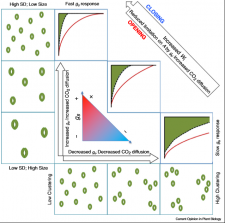 Identifying methods to improve crop productivity is vital considering the devastating consequences of climate change (e.g., frequent droughts). Stomatal conductance influences photosynthesis and water use efficiency, which are two important indicators of crop yield. Here, Faralli et al. discuss advances in understanding how stomatal traits vary and how these may be manipulated to improve stomatal conductance. Genetic manipulation of stomatal conductance is discussed with the view to stabilise yield and water use in crop species. Natural variation of stomatal conductance exists within populations and is identified as an underutilised non-GM target for crop breeding programs (Summary by Alex Bowles) Curr. Opin. Plant Biol. 10.1016/j.pbi.2019.01.003.
Identifying methods to improve crop productivity is vital considering the devastating consequences of climate change (e.g., frequent droughts). Stomatal conductance influences photosynthesis and water use efficiency, which are two important indicators of crop yield. Here, Faralli et al. discuss advances in understanding how stomatal traits vary and how these may be manipulated to improve stomatal conductance. Genetic manipulation of stomatal conductance is discussed with the view to stabilise yield and water use in crop species. Natural variation of stomatal conductance exists within populations and is identified as an underutilised non-GM target for crop breeding programs (Summary by Alex Bowles) Curr. Opin. Plant Biol. 10.1016/j.pbi.2019.01.003.
Review: MicroRNAs and their regulatory roles in plant–environment interactions ($)
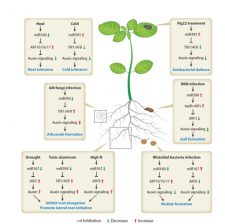 MicroRNAs (miRNAs) are endogenous small noncoding RNAs that negatively regulate the expression of target genes through mRNA cleavage, translational repression and DNA methylation. The last decade has seen an exponential increase in the studies performed to understand the biogenesis of plant miRNAs, their biological and molecular functions, and mechanisms and regulations of their actions. In this context, Song et al. have presented a comprehensive review of plant miRNA biogenesis, mode of actions, and their roles in plant-environment interactions. The biogenesis of miRNA is largely conserved as the miRNA genes undergo transcription to produce primary miRNAs that are processed into miRNA duplexes by DCL (Dicer-like) proteins. These miRNA duplexes are methylated, and the guide strand is incorporated into AGO (Argonaute) proteins to form the miRNA-induced silencing complex (miRISC). miRNAs having near-perfect complementarity with their targets favor target mRNA cleavage; however, several proteins are also reported to interact with miRISC and affect different steps of translation to result in translational repression. Further, a couple of studies provide compelling evidence on miRNA-directed DNA methylation in the nucleus. miRNA-mediated developmental plasticity is a well-studied approach equipped by plants to circumvent the environmental stresses. Abiotic stress-tolerance responses are regulated by the miRNA modules that are evolved in plants, and a few modules are evolutionarily associated with plant environmental adaptation. In case of biotic stress response, miRNAs are capable of directly regulating the defense response or indirectly by acting as a molecular switch to coordinate plant growth and immunity by targeting R genes. (Summary by Muthamilarasan Mehanathan) Annu Rev Plant Biol 10.1146/annurev-arplant-050718-100334
MicroRNAs (miRNAs) are endogenous small noncoding RNAs that negatively regulate the expression of target genes through mRNA cleavage, translational repression and DNA methylation. The last decade has seen an exponential increase in the studies performed to understand the biogenesis of plant miRNAs, their biological and molecular functions, and mechanisms and regulations of their actions. In this context, Song et al. have presented a comprehensive review of plant miRNA biogenesis, mode of actions, and their roles in plant-environment interactions. The biogenesis of miRNA is largely conserved as the miRNA genes undergo transcription to produce primary miRNAs that are processed into miRNA duplexes by DCL (Dicer-like) proteins. These miRNA duplexes are methylated, and the guide strand is incorporated into AGO (Argonaute) proteins to form the miRNA-induced silencing complex (miRISC). miRNAs having near-perfect complementarity with their targets favor target mRNA cleavage; however, several proteins are also reported to interact with miRISC and affect different steps of translation to result in translational repression. Further, a couple of studies provide compelling evidence on miRNA-directed DNA methylation in the nucleus. miRNA-mediated developmental plasticity is a well-studied approach equipped by plants to circumvent the environmental stresses. Abiotic stress-tolerance responses are regulated by the miRNA modules that are evolved in plants, and a few modules are evolutionarily associated with plant environmental adaptation. In case of biotic stress response, miRNAs are capable of directly regulating the defense response or indirectly by acting as a molecular switch to coordinate plant growth and immunity by targeting R genes. (Summary by Muthamilarasan Mehanathan) Annu Rev Plant Biol 10.1146/annurev-arplant-050718-100334
Review: CRISPR/Cas genome editing and precision plant breeding in agriculture ($)
 To fulfill global food demand in the near future, plant researchers keep pursuing simpler and faster crop breeding strategies. CRISPR/Cas systems have been developed as a powerful tool for plant genome editing. In this review, Chen et al. highlight in detail advances in CRISPR/Cas9 and its variants and how to apply these tools in crop genome editing. Here, base editing tools, which allow targeted nucleotide substitutions, are described. Various delivery systems, especially DNA-free methods, which link genome editing with crop breeding, are summarized as well. CRISPR/Cas systems can be used for precision plant breeding, such as trait improvement, enhancing virus resistance, fine-tuning gene regulation, and generating high-throughput mutant libraries. Furthermore, this review discusses the challenges and opportunities for future precision agriculture. These versatile and robust approaches bring hope to both basic plant research and crop precision breeding. (Summary by Jin Liao) Annu. Rev. Plant Biol. 10.1146/annurev-arplant-050718-100049
To fulfill global food demand in the near future, plant researchers keep pursuing simpler and faster crop breeding strategies. CRISPR/Cas systems have been developed as a powerful tool for plant genome editing. In this review, Chen et al. highlight in detail advances in CRISPR/Cas9 and its variants and how to apply these tools in crop genome editing. Here, base editing tools, which allow targeted nucleotide substitutions, are described. Various delivery systems, especially DNA-free methods, which link genome editing with crop breeding, are summarized as well. CRISPR/Cas systems can be used for precision plant breeding, such as trait improvement, enhancing virus resistance, fine-tuning gene regulation, and generating high-throughput mutant libraries. Furthermore, this review discusses the challenges and opportunities for future precision agriculture. These versatile and robust approaches bring hope to both basic plant research and crop precision breeding. (Summary by Jin Liao) Annu. Rev. Plant Biol. 10.1146/annurev-arplant-050718-100049
Review: Brassinosteroid signaling in plant development and adaptation to stress ($)
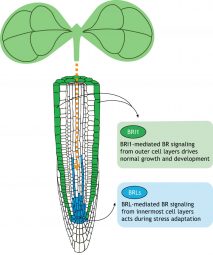 In this new review, Riverola et al. highlight the significance of the phytohormone brassinosteroid in plant development and responses to stress. The authors discuss BRL1, LRR-RLK receptor mediated signaling mechanism that is crucial for root development and stress response. This signaling mechanism varies at the tissue specific level. Regions where the receptors are enriched are involved in cell elongation, stem cell maintenance, and root vascular cell differentiation. The authors also review the role of brassinosteroids under stress conditions including drought, salinity and elevated temperatures, particularly the trade-offs between growth and stress. Ongoing efforts need to address the downstream players and spatio-temporal activity of this phytohormone at tissue specific level. (Summary by Suresh Damodaran) Development 10.1242/dev.151894
In this new review, Riverola et al. highlight the significance of the phytohormone brassinosteroid in plant development and responses to stress. The authors discuss BRL1, LRR-RLK receptor mediated signaling mechanism that is crucial for root development and stress response. This signaling mechanism varies at the tissue specific level. Regions where the receptors are enriched are involved in cell elongation, stem cell maintenance, and root vascular cell differentiation. The authors also review the role of brassinosteroids under stress conditions including drought, salinity and elevated temperatures, particularly the trade-offs between growth and stress. Ongoing efforts need to address the downstream players and spatio-temporal activity of this phytohormone at tissue specific level. (Summary by Suresh Damodaran) Development 10.1242/dev.151894
Perspective. Genetic engineering for disease resistance in plants: Recent progress and future perspectives
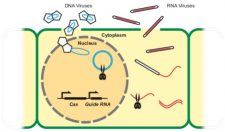 Providing a sufficient nutrition to the ever growing population in the world is the main focus of modern agriculture. Most of the crop yield loss happens due to pathogenic attack. Conventional breeding plays an important role in reduction of loss, but is very time consuming and labor intensive. On the other hand, genetic engineering possesses lots of advantages over conventional breeding. Methods such as transformation, deletion, insertion and replacement of DNA to get the desired trait incorporated in plants are used in genetic engineering. Scientists have successfully incorporated important traits in plants by using these modern techniques and have shown the effect on disease resistance. In this perspective, Dong and Ronald review the progress and future perspectives of genetic engineering for disease resistance in plants, including the use of RNAi for viral resistance, CRISPR/Cas, and resistance gene encrichment sequencing (RenSeq), as well as methods for R gene stacking. The authors summarize the application and importance of genetic engineering along with its limitation in real-world applications. (Summary by Mugdha Sabale) Plant Physiol. 10.1104/pp.18.01224
Providing a sufficient nutrition to the ever growing population in the world is the main focus of modern agriculture. Most of the crop yield loss happens due to pathogenic attack. Conventional breeding plays an important role in reduction of loss, but is very time consuming and labor intensive. On the other hand, genetic engineering possesses lots of advantages over conventional breeding. Methods such as transformation, deletion, insertion and replacement of DNA to get the desired trait incorporated in plants are used in genetic engineering. Scientists have successfully incorporated important traits in plants by using these modern techniques and have shown the effect on disease resistance. In this perspective, Dong and Ronald review the progress and future perspectives of genetic engineering for disease resistance in plants, including the use of RNAi for viral resistance, CRISPR/Cas, and resistance gene encrichment sequencing (RenSeq), as well as methods for R gene stacking. The authors summarize the application and importance of genetic engineering along with its limitation in real-world applications. (Summary by Mugdha Sabale) Plant Physiol. 10.1104/pp.18.01224
Tandem fluorescent protein timers for non-invasive relative protein lifetime measurement in plants
 Proteins are in a dynamic state of synthesis and degradation and their half-lives can be adjusted under various circumstances. Many rapidly degraded proteins function as regulatory molecules, such as transcription factors. The rapid turnover of these proteins is necessary to allow their levels to change quickly in response to external stimuli. Other proteins are rapidly degraded in response to specific signals, providing another mechanism for the regulation of intracellular enzyme activity. Accurate protein quantitation is essential to protein studies in a multitude of research topics. A wide array of different methods has been developed but are often unable to distinguish between protein synthesis and degradation. Therefore, specific approaches are required. Here the authors propose the tandem fluorescent protein timers (tFTs) as a powerful approach to quantify dynamic changes in plant protein stability using live imaging with high spatial and temporal resolution. In this technique two different fluorescent proteins are fused, with distinct fluorophore maturation kinetics, which allows protein age identification from the ratio of fluorescence intensities of the two fluorescent proteins. (Summarized by Francesca Resentini) Plant Physiol. 10.1104/pp.19.00051
Proteins are in a dynamic state of synthesis and degradation and their half-lives can be adjusted under various circumstances. Many rapidly degraded proteins function as regulatory molecules, such as transcription factors. The rapid turnover of these proteins is necessary to allow their levels to change quickly in response to external stimuli. Other proteins are rapidly degraded in response to specific signals, providing another mechanism for the regulation of intracellular enzyme activity. Accurate protein quantitation is essential to protein studies in a multitude of research topics. A wide array of different methods has been developed but are often unable to distinguish between protein synthesis and degradation. Therefore, specific approaches are required. Here the authors propose the tandem fluorescent protein timers (tFTs) as a powerful approach to quantify dynamic changes in plant protein stability using live imaging with high spatial and temporal resolution. In this technique two different fluorescent proteins are fused, with distinct fluorophore maturation kinetics, which allows protein age identification from the ratio of fluorescence intensities of the two fluorescent proteins. (Summarized by Francesca Resentini) Plant Physiol. 10.1104/pp.19.00051
A direct connection between PSI & PSII systems in green plants
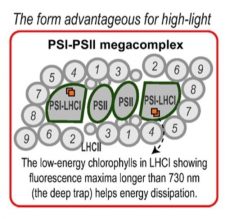 Plants often optimize their development according to the prevailing environmental conditions, of which light is one of the most important. Arabidopsis uses a PSI-PSII megacomplex as the photosystem reaction center, to transfer the excessive energy from PSII to PSI rapidly. Recently, Yokono et al. proposed that sun-plants may accumulate more PSI-PSII megacomplex than shade-plants to increase high-light tolerance. They developed an electron microscopy technique and analyzed chlorophyII fluorescence in representatives from across the green plants, from Streptophyta to Chlorophyta, and found the structure of this megacomplex, which contains one PSII dimer directly sandwiched between two PSIs, enables plants to dissipate excessive energy via deep trap in PSI. This study sheds light on the mechanism of how green plants survive under strong light conditions, and also suggests an ancient and conserved photosystem because this PSI-PSII megacomplex is their common feature of all green plants. (Summary by Nanxun Qin) Plant Cell Physiol. 10.1093/pcp/pcz026
Plants often optimize their development according to the prevailing environmental conditions, of which light is one of the most important. Arabidopsis uses a PSI-PSII megacomplex as the photosystem reaction center, to transfer the excessive energy from PSII to PSI rapidly. Recently, Yokono et al. proposed that sun-plants may accumulate more PSI-PSII megacomplex than shade-plants to increase high-light tolerance. They developed an electron microscopy technique and analyzed chlorophyII fluorescence in representatives from across the green plants, from Streptophyta to Chlorophyta, and found the structure of this megacomplex, which contains one PSII dimer directly sandwiched between two PSIs, enables plants to dissipate excessive energy via deep trap in PSI. This study sheds light on the mechanism of how green plants survive under strong light conditions, and also suggests an ancient and conserved photosystem because this PSI-PSII megacomplex is their common feature of all green plants. (Summary by Nanxun Qin) Plant Cell Physiol. 10.1093/pcp/pcz026
Nitrogen actively controls phosphate starvation response in plants ($)
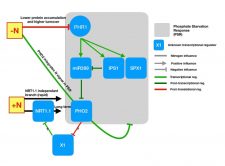 Phosphate and nitrogen are two essential macronutrients for growth of plants. The homeostasis and sensing pathways for these two macronutrients have been investigated extensively, but independently. Recently, -omics approaches have enabled finding interlinks and cross talks between two or more macronutrients. The components for phosphate starvation response (PSR; PHR1, SPX1, IPS2 and PHO2) and nitrogen starvation response (NSR; nitrate transporter 2.4/NRT2.4, NRT2.5) are well known in model plants. Recent studies showed N-P interaction mediated by NITROGEN LIMITATION ADAPTION (NLA) and PHO2 genes. Using transcriptome analysis Medici et al. identified that PSR related genes are induced strongly in the presence of adequate NO3–. PHO2 and PHR1 are directly influenced by N starvation at the transcriptional and protein level respectively. This PSR regulation by nitrogen is systemic in plant tissue and conserved in crop species like wheat and rice. (Summary by Kaushal Kumar Bhati) Plant Cell 10.1105/tpc.18.00656
Phosphate and nitrogen are two essential macronutrients for growth of plants. The homeostasis and sensing pathways for these two macronutrients have been investigated extensively, but independently. Recently, -omics approaches have enabled finding interlinks and cross talks between two or more macronutrients. The components for phosphate starvation response (PSR; PHR1, SPX1, IPS2 and PHO2) and nitrogen starvation response (NSR; nitrate transporter 2.4/NRT2.4, NRT2.5) are well known in model plants. Recent studies showed N-P interaction mediated by NITROGEN LIMITATION ADAPTION (NLA) and PHO2 genes. Using transcriptome analysis Medici et al. identified that PSR related genes are induced strongly in the presence of adequate NO3–. PHO2 and PHR1 are directly influenced by N starvation at the transcriptional and protein level respectively. This PSR regulation by nitrogen is systemic in plant tissue and conserved in crop species like wheat and rice. (Summary by Kaushal Kumar Bhati) Plant Cell 10.1105/tpc.18.00656
The lateral root cap acts as an auxin sink that controls meristem size
 During root growth, cellular activities need to be coordinated across tissues. Mambro et al. have identified molecular mechanisms involved in root apical meristem maintenance by auxin homeostasis regulation in lateral root cap (LRC) cells. The cytokinin response regulator ARR1 regulates expression of the auxin transporter PIN5 and an auxin conjugating amidoacyl transferase, GH3-17, in LRC. PIN5 maintains auxin levels by exporting auxin in to the endoplasmic reticulum, and GH3-17 possibly conjugates IAA with glutamate. Altering the expression of PIN5 and GH3-17 alters root meristem size. Thus the authors have shown the significance of auxin homeostasis by cytokinin signaling in LRC for root meristem size and root development. (Summary by Suresh Damodaran) Curr. Biol. 10.1016/j.cub.2019.02.022.
During root growth, cellular activities need to be coordinated across tissues. Mambro et al. have identified molecular mechanisms involved in root apical meristem maintenance by auxin homeostasis regulation in lateral root cap (LRC) cells. The cytokinin response regulator ARR1 regulates expression of the auxin transporter PIN5 and an auxin conjugating amidoacyl transferase, GH3-17, in LRC. PIN5 maintains auxin levels by exporting auxin in to the endoplasmic reticulum, and GH3-17 possibly conjugates IAA with glutamate. Altering the expression of PIN5 and GH3-17 alters root meristem size. Thus the authors have shown the significance of auxin homeostasis by cytokinin signaling in LRC for root meristem size and root development. (Summary by Suresh Damodaran) Curr. Biol. 10.1016/j.cub.2019.02.022.
Retargeting of a plant defense protease by a cyst nematode effector ($)
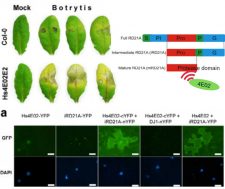 The nematode infection process in plants involves secreted effector proteins that suppress the host defense mechanisms. However, the molecular interactions in which this is done is yet unclear. Here, Pogorelko et al. characterize the function of 4E02, an effector from the cyst nematode H. schachtii, when expressed in A. thaliana. The transgenic plants showed higher susceptibility to this nematode and the necrotrophic fungus B. cinerea. RD21A is a plant defense protease that is expressed in the vacuole and induces programmed cell death (PCD) as an immune response. Using yeast two-hybrid (Y2H) assays and in vivo bimolecular fluorescence complementation (BiFC), the authors found that 4E02 targets RD21A and re-localizes it to the cytoplasm and nucleus. Activity-based protein profiling revealed the enzyme active form is unaltered by its interaction with 4E02. However, in this new location, RD21A targets different proteins affecting cell wall architecture (confirmed by Y2H and cell wall composition analysis), which impacts nematode virulence. Further related studies could lend to advanced control strategies for pathogenic diseases. (Summary by Ana Valladares) Plant J. 10.1111/tpj.14295
The nematode infection process in plants involves secreted effector proteins that suppress the host defense mechanisms. However, the molecular interactions in which this is done is yet unclear. Here, Pogorelko et al. characterize the function of 4E02, an effector from the cyst nematode H. schachtii, when expressed in A. thaliana. The transgenic plants showed higher susceptibility to this nematode and the necrotrophic fungus B. cinerea. RD21A is a plant defense protease that is expressed in the vacuole and induces programmed cell death (PCD) as an immune response. Using yeast two-hybrid (Y2H) assays and in vivo bimolecular fluorescence complementation (BiFC), the authors found that 4E02 targets RD21A and re-localizes it to the cytoplasm and nucleus. Activity-based protein profiling revealed the enzyme active form is unaltered by its interaction with 4E02. However, in this new location, RD21A targets different proteins affecting cell wall architecture (confirmed by Y2H and cell wall composition analysis), which impacts nematode virulence. Further related studies could lend to advanced control strategies for pathogenic diseases. (Summary by Ana Valladares) Plant J. 10.1111/tpj.14295
Seedling traits predict drought-induced mortality linked to diversity loss
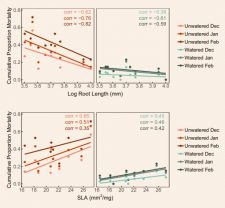 When trying to understand the repercussions climate change will have on future plant communities, trait-based approaches provide valuable insight. Unfortunately, many trait-based studies focus only on the above-ground traits of un-stressed adult plants, ignoring the critical seedling stage. Harrison and LaForgia measured above- and below-ground traits of several native wildflowers and compared seedling mortality between plots that received watering throughout the dry season and plots that remained unwatered, to determine the relationship between traits and drought-related mortality. The strongest predictor of avoiding drought-related mortality was longer seedling root length, followed by a cluster of correlated traits including large seeds, low seedling-specific leaf area, and short seedling height. They found little evidence supporting possible adaptive plasticity in the traits measured, and in fact found that the plants with lower mortality tended to have more stable traits throughout periods of stress. This study highlights the importance of considering appropriate life stages and plant structures when using traits to predict the impacts of climate on a community. (Summary by Rebecca Hayes) Proc. Natl. Acad. Sci. USA 10.1073/pnas.1818543116
When trying to understand the repercussions climate change will have on future plant communities, trait-based approaches provide valuable insight. Unfortunately, many trait-based studies focus only on the above-ground traits of un-stressed adult plants, ignoring the critical seedling stage. Harrison and LaForgia measured above- and below-ground traits of several native wildflowers and compared seedling mortality between plots that received watering throughout the dry season and plots that remained unwatered, to determine the relationship between traits and drought-related mortality. The strongest predictor of avoiding drought-related mortality was longer seedling root length, followed by a cluster of correlated traits including large seeds, low seedling-specific leaf area, and short seedling height. They found little evidence supporting possible adaptive plasticity in the traits measured, and in fact found that the plants with lower mortality tended to have more stable traits throughout periods of stress. This study highlights the importance of considering appropriate life stages and plant structures when using traits to predict the impacts of climate on a community. (Summary by Rebecca Hayes) Proc. Natl. Acad. Sci. USA 10.1073/pnas.1818543116
Untargeted metabolomics reveals host plant chemistry before and after pea aphid infestation
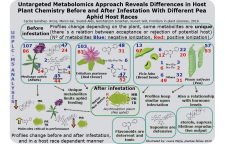 Pea aphids are genetically diverse, with different biotypes (or “host races”) having different host plant preferences. Sanchez-Arcos et al. reveal several relationships between plant metabolite production and the possibility of colonization of certain aphid host races. Using UHPLC- MS analysis of the extracts of Medicago sativa, Trifolium pratense, Vicia faba and Pisum sativum before and after the exposure of different host races of Acyrthosiphon pisum, metabolic profiles were analyzed and correlated. The authors found that profiles change before and after the infestation depending the species of plant. Unique metabolites changes are related to the potential of acceptance or rejection of the host plant aphid hosts. Principal groups of metabolites related to a reduction of population growth due to their deterrent activities are: flavonoids, saponins, triterpenes and peptides. Finally the authors conclude that the technique of untargeted metabolomics allows discovery of plant metabolites with crucial importance in interactions between plants and herbivores or pathogens, revealing susceptibility or resistance. (Summary by Laura Alejandra Mejía Agudelo) Frontiers Plant Sci. 10.3389/fpls.2019.00188
Pea aphids are genetically diverse, with different biotypes (or “host races”) having different host plant preferences. Sanchez-Arcos et al. reveal several relationships between plant metabolite production and the possibility of colonization of certain aphid host races. Using UHPLC- MS analysis of the extracts of Medicago sativa, Trifolium pratense, Vicia faba and Pisum sativum before and after the exposure of different host races of Acyrthosiphon pisum, metabolic profiles were analyzed and correlated. The authors found that profiles change before and after the infestation depending the species of plant. Unique metabolites changes are related to the potential of acceptance or rejection of the host plant aphid hosts. Principal groups of metabolites related to a reduction of population growth due to their deterrent activities are: flavonoids, saponins, triterpenes and peptides. Finally the authors conclude that the technique of untargeted metabolomics allows discovery of plant metabolites with crucial importance in interactions between plants and herbivores or pathogens, revealing susceptibility or resistance. (Summary by Laura Alejandra Mejía Agudelo) Frontiers Plant Sci. 10.3389/fpls.2019.00188


